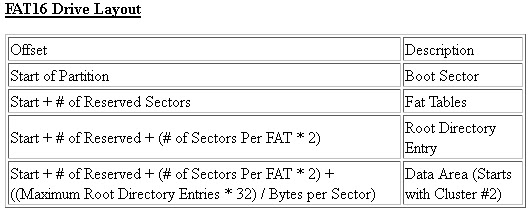FAT16
file system that uses the allocation unit that has a limit of up to 16-bit, so it can store up to 216 units of allocation (65536 pieces). This file system has a capacity limit of up to 4 Gigabyte sizes only. Allocation unit size used by the FAT16 partition depends on the capacity that was about to be formatted: if the partition size is less than 16 megabytes, then Windows will use the FAT12 file system, and if the partition size larger than 16 megabytes, then Windows will use the FAT16 file system. The following table contains information any operating system that supports the FAT16 file system.
FAT32
FAT32 is a version of the FAT file system is the most recent, which was introduced when Microsoft released Windows 95 OEM Service Release 2 (Windows 95 OSR2). Table Windows operating system that supports the FAT32 file system is as follows.
NTFS
Windows NT/2000/XP and Windows Server 2003 supports NTFS natively. NTFS is a filesystem can be restored, which means that it can automatically restore the consistency of the filesystem when something goes wrong. In addition, NTFS supports data compression and encryption, and enables user and group permission levels are defined for files and directories. NTFS volume size is 2TB maximum
Default NTFS Cluster Sizes
The table Boot Sector Sections on an NTFS Volume describes the boot sector of a volume that is formatted with NTFS. When you format an NTFS volume, the format program allocates the first 16 sectors for the boot sector and the bootstrap code.
EXT2
The second extended filesystem, ext2 is an improvement
of the first extended filesystem, which has its origins in the Minix FS. It is
basically unix file semantics with some add ons.
The design goals were, naturally, excellent performance (who doesn't?), robustness and had to include provisions for extensions to allow users to benefit from new features without reformatting their file system. Anyway, it is the de-facto standard Linux file system.
The design goals were, naturally, excellent performance (who doesn't?), robustness and had to include provisions for extensions to allow users to benefit from new features without reformatting their file system. Anyway, it is the de-facto standard Linux file system.
EXT3
is a journaled file system that is commonly used by the Linux kernel. It is the default file system for many popular Linux distributions, including Debian
All file systems include a few basic types of data structures:
Each BSD volume is divided up into a number of cylinder groups (CGs). Each cylinder group is a miniature file system ... with the intent that directory entries in a CG point to I-nodes in the same CG, which point to blocks in the same CG. To the extent this is true, a file can be opened and read with minimal head motion.

The mini-file systems are not truly independent. A directory in one cylinder
group can refer to an I-node in another cylinder group, and an I-node can
point to blocks on any cylinder group. When this happens, however, the
system incurrs additional head motion when processing those files, and
I/O performance is reduced.
is a journaled file system that is commonly used by the Linux kernel. It is the default file system for many popular Linux distributions, including Debian
All file systems include a few basic types of data structures:
- bootstrap code to be loaded into memory and executed when the computer is powered on. MVS volumes reserve the entire first track of the first cylinder for the boot strap.
- volume descriptors information describing the size, type, and layout of the file system ... and in particular how to find the other key meta-data descriptors.
- file descriptors information that describes a file (ownership, protection, time of last update, etc.) and points where the actual data is stored on the disk.
- free space descriptors lists of blocks of (currently) unused space that can be allocated to files.
- file name descriptors data structures that associate user-chosen names with each file.
- Divide the volume into fixed sized blocks. The block size (typically somewhere between 512 and 64K bytes) is chosen when the file system is created. Larger block sizes lead to more efficient I/O, but incur higher losses do to internal fragmentation.
- Reserve the first block of each volume for a bootstrap.
- Place a volume descriptor (superblock, described in section 3) in the second block of the volume.
- Use an I-node (described in section 4) to describe each file.
- Use directories (described in section 6) to associate names with files.
Each BSD volume is divided up into a number of cylinder groups (CGs). Each cylinder group is a miniature file system ... with the intent that directory entries in a CG point to I-nodes in the same CG, which point to blocks in the same CG. To the extent this is true, a file can be opened and read with minimal head motion.






Great, great post! It’s something I have never thought about, really, but it makes a whole lot of sense. Thanks for sharing
BalasHapus1989 Mazda MPV AC Compressor